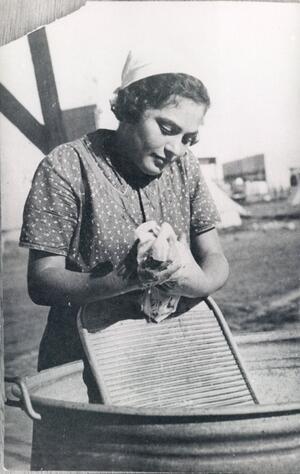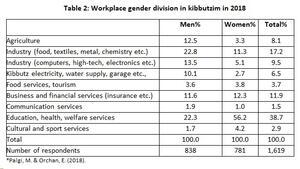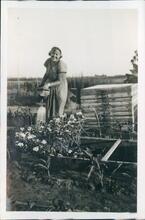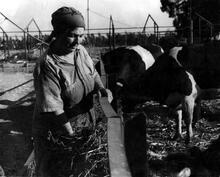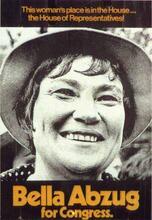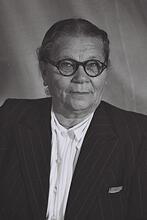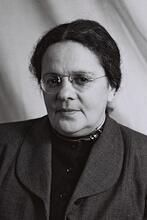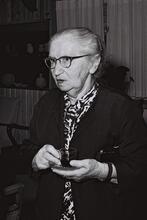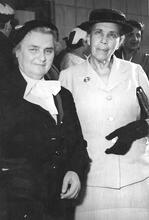Kibbutz
A woman washes laundry on Kibbutz Rodges. Source: The Archive of the Religious Kibbutz, from the PikiWiki website.
Although gender equality was an important part of the kibbutz movement’s discourse, efforts to achieve that equality have been limited by a number of social mechanisms and the kibbutz remains a gendered, male-oriented, male-dominated community. In the pre-state period, kibbutz women struggled to be like men, assuming they would ascent to the level of men. After 1948, kibbutz women were socially constructed as “innate mothers” and men as “producers.” Even today, the social construction of women in the kibbutz continues to equate womanhood and motherhood, the kibbutz gender order reflects the older gendered dichotomy between “the mothers” and “the producers,” and parental roles have been institutionalized.
Introduction
As a secular and democratic community, the kibbutz—first founded in 1910—strove to implement egalitarian principles as expressed in the slogan: “From each according to his ability, to each according to his needs.” In addition, from the 1920s on, due to kibbutz women’s collective action, gender equality became part and parcel of the kibbutz movement’s normative discourse, a kind of “self-understood symbol of this classless society” (Bernstein, 1992; Fogiel-Bijaoui, 1992a; Fogiel-Bijaoui 1992b; Izraeli, 1992; Near, 1992; Reinharz, 1992; Ben Rafael, 2011).
More than a century later, however, the kibbutz is marked by social and economic stratification, while the introduction of differential remunerations for work has given a decisive coup de grace to the former egalitarian ideology (Achouch, 2000; Ben-Rafael, Topel, 2003; Avrahami, 2002). Moreover, it appears that the kibbutz today is a gendered, male-oriented, and male-dominated community (Palgi et al. 1983; Palgi and Adar, 1997; Zamir, 1999; Lieblich, 2002; Fogiel - Bijaoui and Palgi, forthcoming 2021).
To provide a coherent framework for describing and understanding this captivating “venture in utopia” (Spiro, 1971) and the gender order institutionalized in that community, this entry focuses on women’s and men’s agency to analyze the kibbutz’s gender order and the dynamics of social change through four interrelated factors: 1. The social construction of women in the kibbutz, which equates womanhood and motherhood, while the social construction of men identifies manhood as the effective symbol of kibbutz ideology and kibbutz organization. 2. The normative meaning given in the kibbutz to gender equality, constructed here as women’s ascension to the level of men. 3. The gendered allocation of tasks and the structure of the apparatus of production. 4. The institutionalization of parental roles.
Women’s history in the kibbutz can be conceived of as women’s Sisyphean attempts—at the collective and the individual level—to be both normative mothers and equal haverot (female members) in a male-dominated utopian community that institutionalized equality according to masculine standards.
Motherhood and the Struggle For Equality: 1910-1930
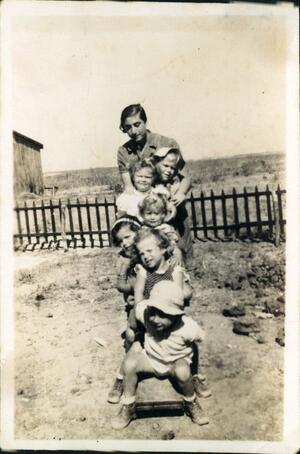
Children at a nursery on Kibbutz Rodges. Women often took responsibility for raising the children on religious kibbutzim, despite efforts to create communal and joint childcare. Source: The Archive of the Religious Kibbutz, from the PikiWiki website.
There can be no doubt that in the two decades between 1911 (the founding of the first A voluntary collective community, mainly agricultural, in which there is no private wealth and which is responsible for all the needs of its members and their families.kevuzah, Deganyah Alef) and 1930, the kibbutz women succeeded in implementing radical changes in order to achieve gender equality. These changes occurred even though the young women of the Second Lit. "ascent." A "calling up" to the Torah during its reading in the synagogue.Aliyah (1904–1918) and the Third Aliyah (1919–1923) were only a small minority among the young halutzim (male pioneers), who were themselves a tiny portion of these two waves of immigrants. In fact, women constituted only 25 to 30 percent of the Third Aliyah halutzim, and that was by far a larger percentage than the percentage of women among the pioneers of the Second Aliyah (Fogiel-Bijaoui, 1992). Like their comrades, the halutzot (female pioneers) came to Palestine to build a new society of agricultural workers according to the Zionist-Socialist ideology. Unlike them, however, at this crossroad of Jewish history, they wanted to create “a new Jewish woman” together with a “new Jewish man” in the “new Jewish society.”
In the kevuzah—a small, intimate agricultural collective and the forerunner of the kibbutz during the Second Aliyah—it seems that the conscious rebellion against traditional Jewish society did not extend to women’s rights and duties: the women were automatically assigned to the kitchen and the laundry, and with the birth of the first children they were automatically given prime responsibility for child care; moreover, women suffered from the degrading attitudes of the men (Maimon, 1955; Bernstein and Lipman, 1992; Izraeli, 1992; Shilo, 1992; Bernstein, 2001).
The women, however, were far from resigning themselves to this situation. On numerous occasions, they raised the problem of their scarcely enviable status within the kevuzah, which was considered the most revolutionary creation of the Jewish Workers’ Movement in Palestine. As early as 1911, the first organized meeting of women took place in Kinneret, on the shore of the Sea of Galilee, to discuss the place of women in the Zionist revolution, in the Jewish Workers’ Movement, and within the kevuzah. At this encounter, the seeds of the Women Workers’ Movement were sown.
By 1914, at the end of the Second Aliyah, the status of women within the collective was radically transformed; the rigid, traditional, and gendered allocation of tasks had loosened up with time. Men had agreed to participate from time to time (not on a regular basis) in performing the “dirty work” hitherto reserved for women: dishwashing, lighting the stoves, carrying heavy pots, chopping wood, cleaning the floor, etc. On the other hand, women had become agriculturalists and had even developed new branches of agriculture, especially market gardening. In addition, after the birth of several children, a communal child-care system was established, since mothers like Miriam Baratz, the first mother in Deganyah, positively refused to give up their work within the kevuzah. Although “collective care” was considered most revolutionary, however, it included neither night hours nor a common dormitory, but “only” the care given the child during the daytime. After the day’s work the child rejoined its parents, played with them, and slept in their room. Nevertheless, such a day-care system did not arouse enthusiasm on the part of all the “founding mothers”—quite the contrary. Most of them had to be convinced that they could give up taking care of their baby in the daytime without the child suffering as a result (Fogiel-Bijaoui, 1992a and Fogiel -Bijaoui b).
Between these positive developments and gender equality, however, there was a long way to go, and in fact within the kevuzah women were never the equals of their male companions. They never entered agricultural production on an equal footing with men; since they were not defined as full-fledged members of the kevuzah, they had no direct earnings and were employed by the male members as wage labor, and even if they worked in agriculture their monthly income was less than that of men. Moreover, they were not always invited to take part in the kevuzah’s internal decision-making. Last but not least, from the very beginning only the women operated the services for children, without the men entering the scene: children were cared for by the women of the kevuzah—by their mothers and the other women acting as “designated mothers,” while the father’s role generally consisted only of playing with his child.
During the Third Aliyah in the early 1920s, a decisive change took place with the foundation of the kibbutz, a more socialist-oriented and larger commune than the kevuzah. One of the main objectives of this change was to encourage true and equal integration of women into collective life. Collective services were established, not only common services such as meals, the kitchen, the refectory, and the laundry (even clothing and showers were collectivized for a time), but also the “children’s house” where children slept together outside their parents’ dwelling (Tsur et al., 1981, 173–213).
As a result, not only did the kibbutz family no longer function as a production unit, but its function as a consumer unit was reduced to a minimum and its educative function was largely restricted, since education and child-care were mostly the task of the community (Shepher and Fogiel-Bijaoui, 1992). The kibbutz family cell now constituted primarily an “emotional shelter” for its members. A parent-child relationship did of course exist, but it was placed under the vigilant eye of the community, personified by the metapelet, the woman in charge of child care. Once out of the hospital, the newborns were housed in the “children’s house” and spent only a few hours daily with their parents in the afternoon (between two and four hours, depending on their age). Modes of education were determined by the kibbutz committee on education. As for the “great fundamental decisions,” they were made by the general assembly of the kibbutz.
It is amazing that gender inequality persisted within such a revolutionary framework, in such a radical society, clearly committed to gender equality. In 1926, for instance, in kibbutz Tel-Yosef (one of the first kibbutzim, founded in 1923), agriculture (the prestigious branch) was conducted almost totally by men, while services (construed as the “non-productive branch”) were almost entirely conducted by women.
Such a gendered division of labor also existed with regard to the key positions of the kibbutzim, as for example at En-Harod, the first kibbutz, founded in 1921 (Kaminsky, 2019). Yokheved Bat-Rachel, one of the leading figures of the kibbutz, writes:
I realized that at En-Harod the secretariat of the kibbutz was all male, even though the women work in the barn, the poultry coop, the garden, and do all kinds of hard work and though, in addition, they carry the burden of raising the children after working hours (Bat-Rachel, 1981, 94).
In order to deal with this situation and ensure a minimal representation of women, a group of En-Harod women, including Bat-Rachel, demanded a quota of one-third for women delegates within the institutions of the Kibbutz Movement and of the workers’ movement in general (Bat-Rachel, 1981, 96). This proposal became the “one-third law” (Hok Ha-Shlish), passed in 1930 in the Kibbutz Hameuchad Movement (with the active support of its leader, Yitzḥak Tabenkin) and in 1945 in the Kibbutz Ha’artzi Movement, which also established a Women’s Division. Over the years, the “one-third law” became a cornerstone of kibbutz legislation, though its application was far from universal (Bat-Rachel, 1981; Palgi, 2012).
To explain why gender inequality persisted even during these two decades, the most revolutionary decades of the communal settlements, we have to refer, on the one hand, to the way gender identities and gender equality were constructed in that revolutionary society, and on the other hand to the way these social constructions came to be implemented in the economic structure of the kibbutz. For instance, during the 1920s, the most radical years of these revolutionary decades, there is no doubt that collectivization of services allowed women to become integrated into production, but this was done “with reservations.”
In fact, deference to masculinity (which came to be expressed in the external appearance of the women, the way they dressed, cut their hair, etc), as well as the importance of physical strength, given the low level of technology at the time, made the halutzim the most “adequate” and most “profitable” workers for agriculture; the economic viability of the kibbutz experiment and its ability to compete with the outside market rested first and foremost on men’s shoulders. As a result, even at the time of collectivization, pioneer women continued to work according to the principle of “internal rotation” as in the Second Aliyah, dividing their activity between certain agricultural branches (the poultry coop, the barn, the vegetable garden, the apiary), auxiliary services (cooking, laundry, cleaning), and child care. Men occasionally participated in auxiliary services (if assigned the duty or during labor shortages), but they were never to be seen in the kitchen and never took care of small children. Since men constituted more than 70 percent of the members, there was no shortage of males and thus no urgent need to call upon women in the agricultural branches (Blumberg, 1983).
The question remains as to how the pioneer women, who denied the legitimacy of profitability as the organizing principle in the capitalist social order, could nevertheless accept it in their “classless society.” The answer is to be found in the social construction of motherhood (O’Reilly 2012) and the way it was institutionalized in the kibbutz. Indeed, collectivization of services and child rearing, radical though they might have been, in no way meant the end of the family or the negation of the parental role. Rather, it meant the end of the patriarchal family and the creation of a new nuclear family, whose existential basis was no longer private property but the affective bonds between its members. Within this context the place reserved for the child in Jewish tradition remained intact. In the kibbutz, just as within the framework of traditional Judaism, the child remained synonymous with love and happiness. Motherhood—constructed as “innate motherhood”—was perceived as the very essence of the feminine nature, enabling any woman, whether or not a mother, to take care of children. That is why, given deplorable living conditions and high child mortality, breastfeeding and no other modern system (which might have relieved women of this “imperative duty”) was unanimously adopted as the only means to ensure the survival of the newborn, thus de facto creating a rigid gendered division of labor.
The mother was therefore the one who not only fed her child, but also took care of all its needs when the child was in its parents’ room. Moreover, according to the kibbutz construction of motherhood, all women were first steered towards tasks involved in the care of children. In other words, the social construction of motherhood in the kibbutz legitimized the organization of production according to criteria of profitability, in the eyes of both halutzim and halutzot.
Many did not accept these principles of collective upbringing, an educational system that undoubtedly implied minimizing family functions and redefining parental functions. Many left the kibbutz, while among those who stayed there was no consensus on the educational system. The price exacted was doubts, rigidity, and anguish. Women were most affected, especially those who wanted to be both equal haverot and (kibbutz normative) mothers (Bassevitch and Bat-Rachel, 1944). To be both mother and pioneer was, it seemed, the maximum equality women could aspire to; the economic and social independence of women, the collective system of education, and the community of services were the very symbols of the feminist-socialist revolution. At that time the kibbutz constituted one of the boldest human experiments, even when compared with the “Big Sister,” Russia. Hence the feeling of impasse, frustration, and sometimes even despair (Fogiel-Bijaoui, 1992a and Fogiel -Bijaoui 1992b ).
Motherhood, Equality and War: 1930-1948

Two women in the Kibbutz Rodges clothing warehouse. Women on religious kibbutzim frequently worked as seamstresses, cooks, caretakers, and in other service positions. Source: The Archive of the Religious Kibbutz, from the PikiWiki website.
During the 1930s the leaders of the kibbutz movement themselves acknowledged the failure in achieving gender equality. In 1935 Meir Yaari (1897–1987), one of the leaders of the radical stream of the kibbutz movement, Ha-Kibbutz ha-Arzi Ha-Shomer ha-Za’ir, speaking at a meeting of his movement, asked: “ Why have we failed so miserably in this field?” (quoted in Fogiel-Bijaouia, 1992, 223).
Data from the late 1940s confirm the validity of Yaari’s remarks (Tiger and Shepher, 1976). Gender equality existed neither in the domain of work nor in the area of politics in the kibbutzim of the time. For instance, in 1948, in eight kibbutzim of the Ihud, a kibbutz federation with a pragmatic socialist orientation, 78.3 percent of the women worked in services (services for adults, childcare, education), compared with 16.7 percent of the men. That same year, 15.2 percent of the women worked in production, compared to 58.2 percent of the men (Tiger and Shepher, 86). The situation was the same in political life. Among 3,400 members of 24 kibbutzim of the Ha-Kibbutz ha-Arzi federation in the years 1943–1944, women’s public/political activity was comparatively low: women were only 29 percent of the members in the various committees and 37 percent among those working in branch management in agriculture, industry and services, and they were only 19.4 percent of those engaged in external political activity,i.e. holding a position within the movement’s federative organization at the national level.
A partial explanation involves the growth of services in the kibbutz during the 1930s and 1940s, following an increase in birth rates and a rise in the standard of living, partly due to the modernization of kibbutz agriculture. Between 1931 and 1948, the kibbutz population grew from 4,391 to 47,408 persons; its percentage of the total Jewish population of Palestine went up from 2.5 percent in 1931 to 7.5 percent in 1948, a record figure never reached either earlier or later. While this noteworthy increase was certainly linked to Jewish immigration to Palestine, the birth rates in the kibbutzim had already risen, since many were now composed of families, with a far more equal ratio of women to men, sometimes up to 50 percent (Fogiel-Bijaoui, 1992a, 225). The rise in the standard of living and the increase in the birth rate allowed and entailed the extension of services, while the work force that was steered toward the services was a distinctly female one.
As in the first two decades of the kibbutz, this gendered allocation of work was based on “economic rationality.” Most women were steered in advance toward services and did not work in “productive sectors,” having no such access to vocational training as the men, which in turn kept them further from the productive sectors. In this context, it was viewed as a waste to bring men, technically prepared for production, into services, or to steer women—who had no vocational training—toward production (Gotzen et al. 2019).
Besides, as they had earlier, the social construction of motherhood and the institutionalization of parenthood supported and reinforced this state of affairs. Indeed, these years, like the earlier ones, were marked by the considerable importance given to the child by kibbutz members. This attitude was expressed by permanent and massive recourse to professionals in education (pediatricians, psychologists, teachers) in order to construct an optimal educational system in the framework of collectivized child-care. In this context, it sometimes seemed that the values of Judaism (the “Jewish Mother”) coincided with the most modern theories in the fields of education, psychology, and medicine by affirming the predominance of the mother over the father in ensuring the optimal development of the child.
Nonetheless, this revolutionary system of upbringing did not please everybody and quite often led to waves of departures, generally at the initiative of women who rejected such modes of childrearing (Maimon, 1955, 152–153). Those who stayed in the kibbutz, especially the women, asked themselves many questions about collective child-rearing, torn between their traditional conception of parenthood and the new definition they were developing. The anguish burst out in almost cyclic fashion during heated discussions, every time the question of kibbutz children was raised (Tsur, 1981, 286–296). Such dilemmas and tensions only served to stress the importance of the “innate mother” in comparison with the father, in the eyes of the men as much as in those of women. As a result of this approach of “innate motherhood,” the gendered division of roles within the families grew more and more traditional. At the collective level, it caused women to gradually leave production and concentrate on child-linked services.
To better understand gender inequality in the kibbutz during the years 1930–1948, however, other factors directly connected to contemporary events must also be taken into account. Especially from the mid–1930s on with the national upsurge of the Arabs of Palestine, the Yishuv (Jewish community in Palestine) was fighting for its survival and its future, and the kibbutz’s role was that of “an elite in the service of the nation.”
Although women participated in the struggle for a national home and eventual independence, this in no way changed the gendered distribution of roles in the kibbutz. Despite their feelings of frustration and anger, the war restrained women from struggling for equality of rights and led them to fight for equality of duties, for two main reasons:
a. In wartime, the rights of the individual and the citizen become secondary, not only so far as the government is concerned but also in the eyes of the individuals themselves (Thébaud, 1998; Goodman, 2002). Thus, at times when issues of life and death were critical for the Yishuv and for the entire Jewish people (World War II), the problem of gender equality became more secondary than ever in the eyes of the kibbutz and of most of its women members.
b. The concept of equality adopted from the start by the women members of the kibbutz was one that made equality of rights subject to equality of duties. Thus the more militant women mobilized for “the right to do their duty” for the Yishuv and the Jewish people, their model being the “real warriors,” i.e. the men (Maimon, 1955, 195 –205; 251–256). In 1936, with the national uprising of the Arabs of Palestine, when men once again denied their female comrades the possibility of standing guard around the kibbutzim, there was a rebellion. Under the leadership of a handful of women from En-Harod, the women of the kibbutzim demanded to be included in the defense of the communes. The “Women’s Rebellion,” as it was called, was both swift and strong and quickly attained its goal. This was the last collective action by women to protest their position in the kibbutz of the pre-1948 era ( Bassevitch and Bat-Rachel, 1944, 89; Chazan, 2015).
However, each time the Haganah (the Yishuv’s main defense organization) assumed new tasks, the debate on the role and contribution of women within its ranks burst forth again with increasing vigor. Such debates also took place within the elite commando of the Haganah, the Palmah, of which one-sixth of the members in 1948 were women, mostly young and single (Elad, 2000).
The role of kibbutz women in the national struggle in no way changed the unequal gender order in the kibbutz, which was economically structured and legitimized by a non-egalitarian definition of parenthood. It was precisely during this period that gender inequality increased, especially in the economic sphere.
In the Name of Motherhood: 1948-1985
With the establishment of the State of Israel in 1948, it became evident that the kibbutz had lost its status as the “socialist vanguard of the future Jewish society.” Most of its national functions (land conquering, populating remote areas, developing agriculture, assuming defense and military roles) were now fulfilled by the state; the percentage of its population in Israeli society was steadily decreasing—4.2 percent of all Israeli citizens in 1952; 2.8 percent in 1983—while its prestige and power also declined. These years were precisely when kibbutz women struggled to resume many of their traditional (Jewish) functions as mothers and wives, while from the 1970s on they also tried to gain some access to the new employment and educational opportunities created by the “kibbutz industrial revolution” (Fogiel-Bijaoui, 1992b, 109–124).
On the surface, the dramatic transition to independence and statehood had no influence on the gender order in the kibbutz community, which remained characterized by the same gender inequality as before. For instance, according to Yonina Talmon-Garber (1970, 61), in the Ihud kibbutzim in the mid-1950s 63 percent of the men and only eleven percent of the women worked in the high-status “productive” branches; the same year, 73 percent of the women and only eleven percent of the men worked in services. The same situation existed at the decision-making level of the kibbutz: eleven percent of the male members and only two percent of the female members were in charge of any public function. On the whole, women did not hold powerful positions such as treasurer, general economic manager, or general secretary. A decade later, the figures were more or less the same for the Ha-Kibbutz ha-Arzi (Leon, 1969, 130-132).
As Amia Lieblich (2002, 67) puts it:
[…] there was always a predominance of women in the “services” while men were free to work in the high-status “productive” branches. Thus women’s work was of lesser community value. The more children were born, the greater proportion of women that had to work in child-care and child-related services, including education on different levels. A pattern was clearly established: men engaged in traditional male occupations—agriculture, industry and other productive work—and women in “services”—child-care, education, kitchen and laundry. Moreover, from its earliest days, the kibbutz’s democratic institutions were almost entirely dominated by men. “Women spoke far less in the general meetings, were rarely elected to the central decision-making bodies of the kibbutz, and virtually never held such administrative posts as farm manager or secretary.” Women were active only in committees within their own occupational domains, namely education, health, clothing and the distribution of consumer goods” (Near, 1992, 367).
This description is only partial, for it does not take into account the role women played in the 1950s and 1960s in initiating and leading a drastic reform, which resulted in minimizing the collectivization of child-care and the educational system and in bringing the children back home. Indeed, in the 1950s and 1960s kibbutz members promoted individualistic changes in their daily life. Central to this trend was women’s desire to revert to many of their traditional functions as “real wife and mother.” For instance, more and more women began to launder and iron themselves because they were critical of the quality of the collective service; a four o’clock family snack was instituted, at which parents and children—and sometimes grandchildren—met in the parents’ room; more and more members began to have their evening meal in their room instead of in the collective dining-room. In the 1960s a “love-hour” was even adopted where young mothers could come to the children’s house in the middle of their work-day for 30 to 60 minutes in order to breastfeed and/or play with their children. Women’s concentration in the services and men’s concentration in production certainly explain the fact that the male members and the kibbutz establishment accepted this behavior; after all, these changes affected neither the economic structure of the kibbutz nor the basic values of the collective, since women, as service workers, worked in the kibbutz and could come to the children’s house for a while before returning to work (Shepher, Fogiel-Bijaoui, 1992, 30–41).
It is precisely in this context that women brought about the most radical change in the kibbutz at that time, the transition from collective to familial sleeping arrangements, or women taking leadership in “changing the kibbutz from a collective of individuals to a community of families” (Lieblich, 2002, 70).
The transformation from collective to familial lodging, decided upon in 1967 and implemented during the following decades, was not only a tremendous change in kibbutz life but also an immense expense for all kibbutzim, since it necessitated rebuilding the single room so as to transform it into a family apartment capable of accommodating children. This transition to familial lodging further limited women’s ability to participate in the collective activities and public functions of the kibbutz, for most of the “new” child-care (at night or in the morning, before daycare or school day) and “new” housework fell on women’s shoulders.
Much has been written about what seems to be a paradoxical process: women living in an egalitarian community, ideologically committed to gender equality, fought to institutionalize in that community some of the basic functions and roles allocated to them in patriarchy.
Most certainly, women turned to the family domain out of their frustration with the discrimination against them in the kibbutz from the very beginning; segregated in the inferior “service” branches and excluded from political and economic power positions, women found refuge, i.e. some power and prestige, in their families.
By this time the family had already become the “de facto ally” of the kibbutz, even though the early kibbutz was not family-oriented; some even argue that the early kibbutz was characterized by a virulent antifamilism, though this was not yet de jure. The reasons for the change were mainly connected to demographic factors: the “second generation” was already the main source of population growth, in contrast to the pre-state period, when the kibbutzim were growing thanks to a steady inflow of newcomers (Blumberg, 1983; Shepher, Fogiel-Bijaoui, 1992). In this new context, having children and taking on more responsibility for essential life-maintaining functions within the family home could give women more prestige and some power at the community level, since these were perceived as crucial contributions to the biological and ideological continuity of the community (Shepher, Fogiel-Bijaoui, 1992; Fogiel-Bijaoui, 1992b).
Certainly, in a gendered economic context, where on the one hand the family was achieving more and more power in the community and on the other hand women had considerably less occupational choice and freedom of movement than men, this familistic process demonstrated the strength of women’s aspirations to personal autonomy at the expense of collective control.
To fully understand this paradoxical process, we have to bear in mind that, from the very first, women, as “innate mothers,” experienced conflicts and dilemmas about child-care as regulated by the kibbutz. These dilemmas and conflicts were sometimes expressed as indicated above, even though collective practices were still strongly endorsed and enforced. They came to the fore with the decline in the revolutionary nature of the kibbutz: what “the innate mothers” were ready to accept in the name of the revolution, they were less and less ready to accept in the kibbutz of the 1950s and 1960s, which was no longer the ultimate symbol of the Zionist revolution. They were no longer prepared to separate from their children, especially at a time when, more than ever in the past, the collective sleeping arrangement seemed to them “against nature,” endangering the psychological and physical health of their children (Talmon-Garber, 1959). Their firm stand against collective child-care practices was reinforced by the fact that women of the “second generation,” born in the kibbutz, were already mothers of children of various ages. Recalling growing up in a system which, according to them, was mostly negative or even traumatic—“no hugging, or kissing, or physical warmth”; “We grew up without the basic security needed for survival” (quoted in Lieblich, 2002, 72; for further details, Leshem, 1991)— they were active in the attempt to become autonomous and individual “true mothers” by putting an end to the communal sleeping arrangements.
At first, most kibbutz members opposed this “mothers’ revolution” because they believed that the abandonment of the communal sleeping arrangement was the beginning of the dismantling of the kibbutz way of life. But for the majority, the conception of “innate motherhood” held by most of the women members also reflected their own deep convictions. Thus the historical (and persistent) construction of motherhood and of parenthood finally enabled the “mothers’ victory.”
This critical move towards more traditional functions and roles for the women in the kibbutz was halted somewhat by important changes in the kibbutz economic structure. Between the 1970s and the mid-1980s the kibbutz became an “industrial society,” manufacturing plastics, food, metals, furniture, etc., at the expense of agriculture. At the same time, kibbutz industry became an important component of Israeli industry, in sales, in the number of employees, and particularly in exports. Concurrently with these developments, more and more kibbutz members, men and women, began to attend academic institutions and to study for advanced degrees. This was a new trend since, despite the fact that education, culture and knowledge were always valued in the kibbutz, formal education and formal studies were defined as part of the “bourgeois” heritage and “bourgeois decadence.” Kibbutz members contended that the kibbutz’s ability to transfer its unique system of values to the younger generation required that their educational institutions develop their own programs and methods, and thus they long remained suspicious of non-kibbutz formal education, including higher education. However, from the 1970s on, authority and prestige became more and more grounded on expertise and formal qualifications (Ben Rafael, Topel, 2003; Topel, 2017).
These structural and ideological changes impacted the role and status of kibbutz women in two interrelated ways. Firstly, in those years of accelerated economic growth, kibbutz members—mostly men but also women—served in greater numbers than in the past in the administrative, financial, economic, and cultural positions of the kibbutz, at the local, regional (in kibbutz regional industrial enterprises), or national level, i.e. in the kibbutz federations.
Thus, besides the kibbutz “regular services” (laundry, kitchen, etc.), more women than in the past worked in clerical, industrial, and academic areas. They also became more active at the community level, serving in greater numbers than before as heads of the committees to which they belonged, such as the educational committee or social committee. Some women even served as secretaries of kibbutzim and a very few as treasurers or economic managers (Silver, 1984).
Furthermore, individual voices gained more legitimacy at this time. Men and women were more strongly encouraged than before to follow their desires and talents, and the search for self-realization became an accepted and prevailing slogan. The need for skilled and highly qualified workers in the “industrial kibbutz” certainly contributed to this ideological shift (Fogiel-Bijaoui, 1992b).
These trends, however, did not fundamentally change the gendered patterns of work in the kibbutz: most of the women, “the mothers,” continued to work in the services, while most of the men, the “producers,” kept working in “the really productive, money-earning branches” of industry and agriculture. As before, this gendered allocation of tasks was legitimized by the same social construction of motherhood, according to which the mother was “the innate parent” while the father had only a secondary role. The crucial change was only that women had more housework than in the past, due to the abandonment of communal sleeping arrangements.
At the very beginning of the 1980s, some feminist activists among the kibbutz women decided to organize in order to put the kibbutz’s unequal gender order on the agenda. According to them, gender inequality was a basic principle of kibbutz organization (women–mothers; men–producers) and not merely the individual problem of a “problematic woman.” A new section was constituted: the Gender Equality Section, supported by both Takam (the United Kibbutz Movement, formed in 1980 by a merger between HaKibbutz HaMeuhad and the Ihud) and Ha-Kibbutz ha-Arzi (Silver, 1984; Fogiel-Bijaoui, 2017). Its purpose was to put an end to the “kibbutz double message”: to be an “innate mother” and to “fulfill yourself as an individual.” The strategy was to promote a radical desegregation of gendered social roles as the sine qua non for gender equality.
However, in the 1980s, Israel entered the global neo-liberal economy. Israeli society witnessed a dramatic transformation in its traditional economic structures and reorganized itself under the combined impact of privatization, deregulation, individualization, and competition, according to the new economic climate. This dramatic turn greatly contributed to the 1985 kibbutz social and economic crisis, which led to what can be seen as a process of de-institutionalization of social equality (Achouch, 2000). In this context, the attempts at desegregation were unsuccessful and the Section itself disappeared during the next decade (Palgi, Adar, 1997). In other words, on the eve of the dramatic structural transformation of the kibbutz, women appeared as a powerless group, without control over economic, political, or symbolic resources to lead that transformation or to influence it in any way.
Motherhood in the Kibbutz in the Global Era—The Challenges of Neo-liberalism: 1985–2020
It can certainly be argued that the processes that have transformed the kibbutz since the mid-1980s reflect its gradual but successful economic adaptation to neo-liberal globalization. At the centre of this development are the processes of individualization and privatization. The former refers to a process in which the individual’s desires and needs become the organizing principle of society and the latter to a process in which various aspects of the collective’s economic responsibility are transferred to individuals’ responsibility (Beck & Beck- Gernsheim, 2002; Giddens, 1992).
Since the 1980s, kibbutz members’ freedom of choice has grown, together with autonomy and the declining importance of the former ideology. Today, 80% of the kibbutzim have instituted differential wages that reflect the market value of jobs, in or outside the kibbutz, and replace the egalitarian personal budget, which included budgets for food, culture, housing, and so on (Getz and Goldemberg, 2018). The communal services dealing with traditional “women’s work” in these kibbutzim have been eliminated, diminished, or transformed into paid services. This includes residential children’s houses, the communal kitchen and dining room, and the laundry services. Economic management is now separate from community management, with the work committee being replaced by the human resources unit. Each member now receives a salary and pays progressive community and mutual-guarantee taxes, according to his/her income-level. These developments are accompanied by the opening of the kibbutz gates with the construction of new extension neighbourhoods, the demographic growth following the return of kibbutz-born adults, and diversification in the types of inhabitants that compose the social fabric. Today, several different statuses exist in the kibbutz: ”full members,” who pay full kibbutz progressive taxes, possess full rights in the kibbutz life-style and enjoy full rights over the kibbutz’s collective assets; “members with economic autonomy,” who pay lower taxes to the kibbutz but fully enjoy the kibbutz life-style while having only minimal rights over the collective assets of the kibbutz; and “residents,” who do not pay internal kibbutz taxes, apart from municipal taxes, and who have no rights in kibbutz property, apart from owning their house, with the same applying to their children (Ben Rafael, 2011; Getz & Goldemberg, 2017).
In the kibbutz as elsewhere, economic and cultural adaptation to neo-liberal globalisation is a multi-faceted process with far-reaching consequences for the lives of all women and men. New regimes of social inclusion and exclusion have been constituted, providing new opportunities for individuals and groups but also imposing new constraints on them. In the kibbutz as elsewhere, economic and cultural adaptation to neo-liberal globalization is a gendered process, defined and led by a well-crystallized neo-liberal androcentric discourse that emphasizes the lesser value of womanhood and constructs masculinity as the normative standard (Sassen,1998; Fraser, 2000, 2004; Curty, 2020).
This gendered multifacetedness, fueled by individualization and privatization, is assuredly a characteristic of kibbutz family life nowadays. On the one hand, men have begun to assume a more active, and even more equal, role in the domestic sphere, especially regarding the various aspects of childcare (Gazit-Horev, 2009; Prital, 2009). Moreover, the notions of motherhood, fatherhood, and parenthood are being enlarged, as several kibbutz members have established same-sex families. Unlike the past, they won some recognition and acceptance, facilitating the establishment of LGBT families in secular kibbutzim (Barkai, 2016; Ben Ari, 2002; Walzer, 2000). As Nurit Barkai (2016) describes:
Here, in the kibbutz, I want to live my life as a lesbian. I [feel] safe talking about it, with certainty that nobody would cast me off, reject me, even if people talk behind my back in the kibbutz dining hall. And I didn’t really experience any display of homophobia. In the kibbutz it’s harder to be a homophobe, perhaps because everybody knows your overall identity and so they don’t see you as a stranger. Over time, my roots have grown stronger. My parents are here, my son is here, I was head-teacher of the school in Kibbutz Rosh Hanikra.
On the other hand, these developments did not change the fact that, generally speaking, the responsibility of parenthood still rests primarily on women’s shoulders. Consequently, as “innate mothers,” women still have fewer options regarding their personal choices and self-definitions, compared to their male companions. (Gazit-Horev, 2009; Prital, 2009; Topel 2017; Fogiel-Bijaoui and Palgi Forthcoming 2021)
This gendered multifacetedness is also reflected in the choices kibbutz women have made in the spheres of studies and work. Many women have made choices outside what for decades had been women’s spheres, i.e., education and services. To some extent, this has been possible because embarking on studies no longer depends on funding from the kibbutz, nor does it require permission from various kibbutz committees. Moreover, these “non-yielding” services have been restructured to become money-making branches, i.e. professional business spheres that generate income, so women working there have acquired more recognition, appreciation, and esteem.
Table 1 reflects this evolution, presenting managerial positions according to gender in the kibbutz of the 2010s. Echoing the present-day zeitgeist, jobs have received new titles, reflecting a business orientation. This includes managerial positions, which were once women’s spheres–now called, for instance, management of education or of social affairs.
Yet Table 1 also reveals the limits of this evolution: men held most of the economy-related positions, so women’s activities, however important, still seem to be less prestigious. It can be argued that gendered perceptions and the practices they nurture still constitute taken-for-granted mechanisms that re-produce gendered hierarchies. (Adar-Rotem, 2013; Gazit-Horev, 2009; Gommeh-Lahav, 2013; Prital 2009; Topel, 2017).
Moreover, the structure of occupations and wage-levels of women and men in various spheres, as depicted in Table 2 and Table 3, reveals the same pattern.
For instance, Table 2 shows that more than twice the number of women (56.2%) than men (22.3%) work in public and community services: education, health, social affairs, and administration. The same picture manifests itself in the level of wages. Table 3, which presents the levels of earnings in kibbutzim based on gender, also illustrates this point. (This relates to the renewed kibbutzim. In the collective kibbutzim there is an egalitarian budget system).
As an example, it appears that 70.2% of women’s monthly earnings fell in the low and mid-levels (up to NIS 5,500 and from NIS 5,501 to NIS 9,000, respectively). In contrast, only 51.5 % of men fell at these levels: 19.8% up to NIS 5,500 and 31.7% from NIS 5,501 to NIS to NIS 9,000. These data and those of Nahum Gilboa (2014) do not methodically describe the gendered wage-gaps found at the highest management levels, where the monthly salary often rises above NIS 30,000. However, other research (Gommeh-Lahav, 2013; Topel, 2017) reveals a prominent system-wide gendered wage-gap, including the most senior positions.
Finally, allocation of kibbutz resources also has a generational dimension that interacts with the gender dimension. As women fulfil most familial tasks, compelling then to coordinate these tasks with their work responsibilities,they tend to work in public and community services, which nowadays often offer only unstable employment conditions and below-average wages. Hence young mothers and single mothers tend to find themselves in the lowest levels of wages. We can assume that this situation has, in turn, contributed to a declining birth rate in many kibbutzim in the past few years. The kibbutz birth rate now resembles that of Jewish women in Israel as a whole (3 births) and contrasts with the earlier(principally up to the 1970s), when it was higher than the average birth rate of Israeli Jewish women (Ebenstein, Hazan & Simhon, 2016 ).
Moreover, the income of older women who had to enter the neoliberal job market is sometimes extremely low. It is difficult to find a place of work that accepts older women. Their professional skills in education and services, which were suitable for the kibbutz of the past, may not be appropriate in the contemporary kibbutz. Besides, in contrast to the past, retirement age in the kibbutz is now in line with the outside. Thus, retirement age for 70% of women kibbutz members is 65 or below, in comparison to only 12% of the male kibbutz members who retire at that age (The Kibbutz Movement, 2018, p. 53).
Women ‘s representation in the public institutions is also clearly a multifaceted gendered issue in today’s kibbutzim. However, a process is currently unfolding that could influence the gender order in kibbutz society. As previously argued, women are indeed filling central roles and are key office holders in the community, reflecting a certain modification in the kibbutz’s historical approach, which used to highlight gender differences as the foundation of the social order. Moreover, the Gender Equality Section, was reorganized in 2000, when the Takam and the Hakibbutz HaArzi merged and became what is now the Takatz (the Kibbutz Movement). The section’s new name is the Unit for Gender Equality in the Kibbutz Movement, the Moshav Movement and Rural Regions and it has even been extended, with a special emphasis on political representation at the level of the regional councils (Moatzot Ezoriot) in which the predominant form of communities represented are kibbutzim and moshavim.
The focus on political representation, in collaboration with other NGOs, has brought improvement for kibbutz women in the regional councils. Hence the 2018 regional elections resulted in an increase in women’s representation, including many kibbutz women: 216 women were elected, representing 19% of all regional councils’ members, compared to 12.6% before these elections (Moatzot Ezoriot - https://www.mhh.org.il/he/articles/item/780/; Fogiel-Bijaoui and Palgi Forthcoming 2021)
On the other hand, as described above, men still hold the most prestigious positions in the community, which are generally economy-related positions. Besides, the representation of women in regional councils (19%) remains low, compared to that of men. In addition, among the three women elected as head of one of the 54 Regional Councils were no kibbutz women. At the national level (Knesset, Government), no kibbutz woman has been elected in many years.
Nonetheless, at present, the relatively successful focus on regional politics may have some impact on kibbutz women and may revive their involvement in institutional politics, encouraging them to re-enter the institutional political arena. “The local” is on the rise and the influence of local authorities in Israel is growing. Moreover, over the years local authorities have gained the trust of a critical mass of citizens (Oomen and Baumgärtel 2018; Cohen 2018; Shapira and Finkelstein 2020). Finally, COVID -19 is transforming the rules of the game, and even in such a centralized regime as Israel, it puts the local actors at the forefront of the new era (Finkelstein 2020). In other words, a crack may be forming in the gendered political glass ceiling of the kibbutz.
Conclusion
This article has presented a brief outline of “mothers in utopia,” describing women’s Sisyphean attempts to be “mothers and equal members” of the kibbutz. It has shown how, in the pre-state period, kibbutz women struggled to be like the men—at work, in public functions, and in war—assuming that they would ascend to the level of men. For them, equality meant equality of duties, a pre-condition for equality of rights with their masculine model.
In 1948, after the establishment of the state, when it became evident that there would be no socialist revolution and that the kibbutz had lost its status as the “elite in the service of the nation,” kibbutz women, mostly of the second generation, struggled to end the communal sleeping arrangements so as to be “real mothers” and to get their children back home. This familistic process demonstrated women’s aspiration to personal autonomy at the expense of collective control, at least in family life.
During these years, kibbutz women were socially constructed as “innate mothers” and kibbutz men as “producers.” These definitions structured the unequal gender order of the kibbutz and gave it its legitimacy in the eyes of the women as well as of the men.
In the 1980s, on the eve of the great neo-liberal transformation of the kibbutz and its adaptation to the global era, “women-the-mothers” constituted a powerless group, lacking control over the economic, political, or symbolic resources required to lead this transformation or influence it. In consequence, the neo-liberal transformation of the kibbutz, at the center of which were individualization and privatization, was a gendered process, defined and led by a well-crystallized androcentric discourse. Due to new mechanisms of inclusion and exclusion that accompany the neo-liberal era, some kibbutz women, especially the younger, more highly educated women, have been successful in improving their personal status; on the other hand, other women, especially older ones, felt that the adaptation of the kibbutz to the global era has been a kind of exclusion, which has not always improved their status.
Today, following the increase in the level of education, the diversification in professions, and the echoing of feminist discourse inside and outside the kibbutz, gender boundaries have become slightly less inflexible within the family and at work. Nonetheless, the kibbutz gender order still reflects the old gendered dichotomy between “the mothers” and “the producers,” although in the field of representation, a process is currently unfolding that could impact the picture.This process has been furthered by the Covid pandemic, which, in the kibbutz as elsewhere, affects the gender order. The drop in employment related to social distancing measures has had a large impact on sectors with high women’s employment shares, and closures of schools and daycare centers have massively increased child care needs and had a particularly large impact on working mothers. On the other hand, flexible work arrangements are being adopted that are likely to persist. Moreover, many husbands, companions, and fathers are taking more responsibility for housework, especially for childcare. Communal meetings organized through Zoom allow for greater participation, of men as well as of women (Kavaler 2020).
Thus, the history of the gender order in the kibbutz is similar to that of other communes, secular or religious, in the modern era. The gender order has always been unequal, for there has never been a re-definition of equal parenthood, nor a structuring of the apparatus of production as a function of an egalitarian definition of manhood, womanhood, and parenthood (Oved, 1988, 2017; Fogiel - Bijaoui, 1992c). In other words, the communal experience teaches us that for those who strive to implement gender equality, these are the most radical changes. In the context of what could be an ongoing change of the kibbutz gender order, boosted by the Covid pandemic, even in the religious kibbutzim (on religious kibbutzim: Katz,1995; Friedman-Rosenberg 2017), it is also a crucial lesson for those communities that still choose to be a democratic alternative, beyond populism and social Darwinism.
Abrahami, Ely. Kibbutz 2000 as Seen by Its Members (Hebrew). Efal:Yad Tabenkin, the Research and Documentation Center of the United Kibbutz Movement, 2002.
Achouch, Yuval. “To Reconstruct Inequality: Remuneration for Work and Actors’ Strategies to Increase Income in the Kibbutz.” Journal of Rural Cooperation 28/1 (2000): 3–18.
Adar-Rotem, Ravit. “Women, Work, and Satisfaction in the Changing Kibbutzim.” In Private and Public: Women in the Kibbutz and the Moshav, (Hebrew). Edited by Sylvie Fogiel-Bijaoui and Rachel Sharaby, pp. 410-438. Jerusalem, Magnes Press and Efal: Yad Tabenkin, the Research and Documentation Center of the United Kibbutz Movement, 2013.
Barkai, Nurit. “It is Hard to Grow Old as an LGBT in Israel.” (Hebrew). Retrieved from: https://www.haaretz.co.il/magazine/.premium-MAGAZINE-1.2963173: 2016.
Bassevitch, Lila. Only an Echo (Hebrew). Tel Aviv: Hakibbutz Hameuchad, 1981.
Bassevitch, Lila and Yokheved Bat Rachel. Women in the Kibbutz (Hebrew). Edited together with Menachem Poznanski and Moshe Shori. Ein Harod and Tel Aviv, Hakibbutz Hameuchad, 1944.
Bat-Rachel, Yokheved. The Path I Took (Hebrew). Efal and Tel Aviv: Yad Tabenkin, the Research and Documentation Center of the United Kibbutz Movement and Hakibbutz Hameuchad, 1981.
Beck, Ulrich and Elizabeth Beck-Gernsheim. Individualization, Institutionalized Individualism and its Social and Political Consequences. Thousand Oaks, California: SAGE Publications, 2002.
Ben-Ari, Adital T. “Experiences of ‘Not Belonging’ in Collectivistic Communities: Narratives of Gays in Kibbutzes.” Journal of Homosexuality 42(2), 2002:101-124.
Ben-Rafael, Eliezer. Crisis and Transformation. Albany, NY: SUNY Press, 1981.
Ben-Rafael, Eliezer. “Kibbutz: Survival at Risk.” Israel Studies 16(2), 2011: 81–108.
Ben-Rafael, Eliezer and Menachem, Topel. “The Kibbutz Transformation—Who Leads It and Where?” In Jews in Israel—Contemporary Social and Cultural Patterns, edited by Uzi Rebhun and Chaim Waxman. Waltham, MA: University Press of New England, 2003.
Bernstein, Deborah “Introduction.” In Pioneers and Homemakers, Jewish Women in Pre-State Israel, edited by Deborah Bernstein, 1-23. Albany, NY: State University of New York Press, 1992.
Bernstein, Deborah. “Women of the Second Aliyah: Life Stories.” In Will You Listen To My Voice? Representations of Women in Israeli Culture (Hebrew). Edited by Yael Azmon, 116–133. Jerusalem and Tel -Aviv, Van Leer Institute and Hakibbutz Hameuchad, 2001.
Bernstein, Deborah and Musiah Lipman. “Fragments of Life: From the Diaries of Two Young Women.” In Pioneers and Homemakers: Jewish Women in Pre-State Israel, edited by Deborah Bernstein, 145–164. Albany, NY: State University of New York Press, 1992.
Blumberg, Rae. L. “Kibbutz Women: From the Fields of Revolution to the Laundries of Discontent.” In Sexual Equality – The Israeli Kibbutz Tests the Theories, edited by Michal Palgi, Joseph R. Blasi, Menachem Rosner, and Marilyn Safir, 130–150. Norwood, PA: Norwood Editions, 1983.
Chazan, Meir. The Modest Revolution - Women and Defense in Palestine, 1907-1945 (Hebrew). Tel-Aviv: Hakibbutz Hameuchad, 2015.
Cohen, Amichai. The 2018 Local Elections in Israel-Hate / Love Relationships between the Central and the Local Authorities (Hebrew). Jerusalem: The Israel Democracy Institute, 2018.
Curty, Gaël. “Rethinking Capitalism, Crisis, and Critique: An Interview with Nancy Fraser.” Critical Sociology, April 27, 2020.
Ebenstein, Avraham, Moshe Hazan and Avi Simhon. “Changing the Cost of Children and Fertility: Evidence from the Israeli kibbutz.” The Economic Journal 126, 2016: 2038–2063.
Elad, Ofra. “Women in the Palmah.” In Palmah: Sheaves and Sword (Hebrew), 211-251. Tel Aviv: Ministry of Defense and Galili Center for Defense Studies, 2000.
Finkelstein, Ariel. On the Importance of Local Government, https://www.idi.org.il/articles/32265, (Hebrew) Jerusalem: (1.9) 2020.
Fogiel-Bijaoui, Sylvie (A). “Motherhood and Revolution: The Case of Kibbutz Women, 1910–1948.” In Pioneers and Homemakers: Jewish Women in Prestate Israeli Society, edited by Deborah Bernstein, 211–233. Albany, NY: State University of New York, 1992.
Fogiel-Bijaoui, Sylvie (B). Motherhood and Revolution: The Case of Kibbutz Women 1910–1990 (Hebrew). Tel Aviv: The Open University, 1992.
Fogiel-Bijaoui, Sylvie (C). Gender in Utopia—Kibbutz Women in the 1920s: A Comparison with Other Communities. Tel Aviv: Research conducted under the auspices of the Wiener Seminar, Tel Aviv University. Efal: Yad Tabenkin, the Research and Documentation Center of the Kibbutz Movement, 1992.
Fogiel-Bijaoui, Sylvie. “The Politics of Co-optation: The Kibbutz ‘Gender Equality Departments’, 1982–2015.” In Dynamics of Gender Borders: Women in the Kibbutz and the Moshav, edited by Fogiel-Bijaoui, Sylvie and Rachel Sharabi, 315-328. Berlin/Boston and Jerusalem: De Gruyter, 2017.
Fogiel-Bijaoui, Sylvie and Palgi, Michal. “Recognition, Redistribution, Representation: Women in the Kibbutz Today.” In The Metamorphosis of the Kibbutz, (pp.103-120), edited by Ben-Rafael, Eliezer and Orna Shemer, 103-120. Leyden and Boston : Brill- International Comparative Social Studies (In print).
Gazit-Horev, Naama. “‘We Will Live and We Will See’: The Family in Kibbutz Kiryat Anavim in a Period of Uncertainty.” In Old Dreams, New Horizons:Kibbutz Women Revisited (Hebrew), edited by Sylvie Fogiel-Bijaoui, 235-254. Tel-Aviv - Hakibbutz Hameuchad and Efal: the Research and Documentation Center of the Kibbutz Movement, 2009.
Fraser, Nancy. “From redistribution to Recognition? Dilemmas of Justice in a Post-Socialist Age.” New Left Review 212 (1), 1995: 68-93.
Fraser, Nancy. “Rethinking Recognition.” New Left Review 3, 2000: 107-120.
Getz, Shlomo and Hanna Goldemberg. A Survey of Demographic Growth in the Kibbutz-2017 (Hebrew). Haifa Institute for the Research of the Kibbutz and the Cooperative Idea, Haifa University, 2017.
Getz, Shlomo and Hanna Goldemberg. Collective Kibbutzim – An Update Report for the End of 2018. (Hebrew). Haifa Institute for the Research of the Kibbutz and the Cooperative Idea, Haifa University, 2018.
Giddens, Anthony. The Transformation of Intimacy: Sexuality, Love and Eroticism in Modern Societies. Stanford: Stanford University Press, 1993.
Gilboa, Nachum. “Survey of Kibbutz Wages.” Mynet Kibbutz (Hebrew). Retrieved from http://mynetkibbutz.co.il/article/152494: 2014.
Gommeh-Lahav Maya. “Hidden Practices of Gender Inequality in the Renewing Kibbutz: A Case Study.” In Private and Public: Women in the Kibbutz and the Moshav, edited by Sylvie Fogiel-Bijaoui Rachel Sharaby (Hebrew), 382-409. Jerusalem: Magnes Press, and Efal: Yad Tabenkin, the Research and Documentation Center of the United Kibbutz Movement, 2013.
Goodman, Philomena. Women, Sexuality and War. Basingstoke and New York: Palgrave Macmillan, 2002.
Gottzen, Lucas, Ulf Mellstrom, and Tamara Shefer, eds.Routledge International Handbook of Masculinity Studies. London: Routledge, 2019.
Izraeli, Dafna. “The Women Workers’ Movement: First-Wave Feminism in Pre-State Israel.” In Pioneers and Homemakers: Jewish Women in Pre-State Israel, edited by Deborah Bernstein, 183–209. Albany, NY: State University of New York Press, 1992.
Kaminski, Tami. By Their Own Way: The Women of Ein Harod as Shapers of an Innovative Society, 1921-1948 (Hebrew). Efal and The Ben-Gurion Institute: 2019.
Katz Yossi. “The Religious Kibbutz Movement and its Credo, 1935–48.” Middle Eastern Studies. 31, 2 (1995): 253-280.
Kavaler, Tara. “Kibbutzim: Socialist Communities in the Age of Social Distancing. The Media Line https://themedialine.org 30.3 (2020).
Leon, Dan. The Kibbutz—A New Way of Life. Oxford: Pergamon, 1969.
Leshem, Nurit. The Song of the Grass (Hebrew). Efal: Yad Tabenkin, the Research and Documentation Center of the United Kibbutz Movement, 1991.
Lieblich, Amiya. “Women and the Changing Israeli Kibbutz: A Preliminary Three-Stage Theory.” In Journal of Israeli History: Special Issue: Women’s Time, New Studies from Israel, edited by Hannah Naveh. 21, 1/2 Part II 2002: 63–84.
Maimon, Ada. Fifty Years of the Women Workers’ Movement (Hebrew). Tel-Aviv: Ayanot, 1955.
Moatzot Ezoriot (Hebrew) https://www.mhh.org.il/he/articles/item/780/.
Near, Henry. The Kibbutz Movement: A History, 1919–1939. Oxford: Littman Library, 1992.
O'Reilly, Andrea, ed. From Motherhood to Mothering: The Legacy of Adrienne Rich's Of Woman Born. Albany, NY: State University of New York Press, 2012.
Oomen, Barbara and Moritz Baumgartlel. “Frontier Cities: The Rise of Local Authorities as an Opportunity for International Human Rights Law.” European Journal of International Law 29 (2), 2018: 607-630.
Orchan, Elyette, Michal Palgi, and Guila Adar. A Survey of Central Executive Officers in the Kibbutz (Hebrew). Haifa Institute for the Research of the Kibbutz and the Cooperative Idea, Haifa University, 2016.
Oved, Yaacov. Two Hundred Years of American Communes. New York: Routledge: 1988.
Oved, Yaacov. Globalization of Communes: 1950-2010. New York: Routledge, 2017.
Palgi, Michal. “Spatial Mismatch and its Effect on Kibbutz Women's Status at Work.” Horizons in Geography 66 (Hebrew), 2006: 65-78.
Palgi, Michal. “The Reciprocal Relationship between Feminism and Communal Life.” In The Communal Idea in the 21st Century, by Eliezer Ben-Rafael and Menachem Topel, 269–279. Leiden–Boston: Brill, 2012.
Palgi, Michal, Joseph R. Blasi, Menachem Rosner and Marilyn Safir, eds. Sexual Equality –The Israeli Kibbutz Tests the Theories. Norwood, PA: Norwood Editions, 1983.
Palgi, Michal and Gila Adar. “Women, Work and Change in the Kibbutz” (Hebrew). In Women and Work in Israel—Breaking the Glass Ceiling, edited by Anat Maor, 215–227. Tel Aviv: Sifriat Hapoalim, 1997.
Palgi, Michal and Elyette Orchan. Opinion Poll in the Kibbutz-2018. (Hebrew). Haifa: Haifa Institute for the Research of the Kibbutz and the Cooperative Idea, Haifa University, 2018.
Prital, Noga. “Career and Family in the Kibbutz.” In Old Dreams, New Horizons: Kibbutz Women Revisited (Hebrew), edited by Sylvie Fogiel-Bijaoui, 255-280. Tel-Aviv - Hakibbutz Hameuchad and Efal: the Research and Documentation Center of the Kibbutz Movement, 2009.
Rosenberg-Friedman, Lilach. "Orthodox, Zionist, Socialist, Female A New Identity for Women in the Early Religious Kibbutzim." In Dynamics of Gender Borders: Women in the Kibbutz and the Moshav, edited by Sylvie Fogiel-Bijaoui and Rachel Sharaby, 39-61. Berlin/Boston and Jerusalem: De Gruyter, 2017.
Sassen, Saskia. Globalization and Its Discontents. New York: The New Press, 1998.
Shepher, Joseph and Sylvie Fogiel-Bijaoui. The Socio-History of the Family in the Kibbutz (Hebrew). Tel Aviv: The Open University, 1992.
Shapira, Assaf and Ariel Finkelstein. On the Importance of the Political Actors at the Local Level (Hebrew). https://www.idi.org.il/knesset-commities/31639. 20.5 (2020).
Shilo, Margalit. “The Women’s Farm at Kinneret, 1911–1917: A Solution to the Problem of the Working Woman in the Second Aliyah.” In Pioneers and Homemakers: Jewish Women in Pre-State Israel, edited by Deborah Bernstein, 119–143. Albany, NY: State University of New York, 1992.
Silver, Vivian. Male and Female He Created Them: Gender Equality in the Kibbutz? (Hebrew). Efal: Yad Tabenkin, the Research and Documentation Center of the United Kibbutz Movement,1984.
Spiro, Melford E. The Kibbutz: Venture in Utopia. New York: Schocken, 1971.
Talmon-Gerber, Yonina. “The Family and the Children’s Sleeping Arrangements in the Kibbutz” (Hebrew). Niv ha-Kevuzah 8 (1959): 2–25.
Talmon-Gerber, Yonina. Individual and Society in the Kibbutz : A Sociological Analysis (Hebrew). Jerusalem: Magnes Publishing House, 1970.
Kibbutz Movement. The Kibbutz Movement Yearbook 2016-2017 (15) (Hebrew) 2018.
Thébaud, Françoise. “The Great War and the Triumph of Sexual Division.” In A History of Women in the West, edited by Françoise Thébaud, 21–75. Cambridge, MA, and London: Belknap Press, 1998.
Tiger, Lionel and Joseph Shepher. Women in the Kibbutz. New York and London: Harcourt Brace Jovanovich, 1976.
Topel, Menachem. “Kibbutz: Transformation, Technocracy, and Gender.” In Dynamics of Gender Borders: Women in the Kibbutz and the Moshav, edited by Sylvie Fogiel-Bijaoui and Rachel, Sharaby, 295-314. Berlin/Boston and Jerusalem: DeGruyter, 2017.
Tsur, Muki, Tahir Zevoulon and Hananyah Porat. Here On The Face of the Earth (Hebrew). Tel Aviv: Hakibbutz Hameuchad and Sifriat Hapoalim,1981.
Walzer, Lee. Between Sodom and Eden: A Gay Journey through Today's Changing Israel. New York: Columbia University Press, 2000.
Zamir, Aviva. Through the Glass Ceiling: Women in Top Managerial Positions in Kibbutz. Efal :Yad Tabenkin, the Research and Documentation Center of the United Kibbutz Movement, 1999 (Hebrew).

